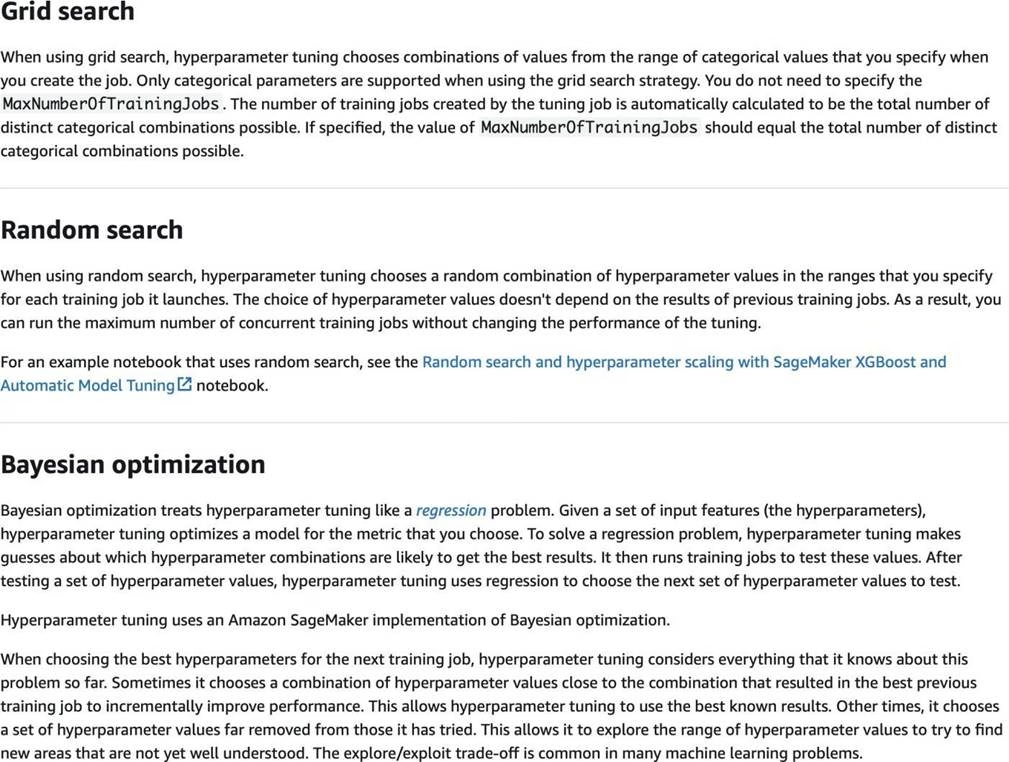Which of the following approaches is MOST LIKELY to improve the effectiveness of the hyperparameter tuning process?
You are tasked with building a predictive model for customer lifetime value (CLV) using Amazon SageMaker. Given the complexity of the model, it’s crucial to optimize hyperparameters to achieve the best possible performance. You decide to use SageMaker’s automatic model tuning (hyperparameter optimization) with Random Search strategy to fine-tune the model. You have a large dataset, and the tuning job involves several hyperparameters, including the learning rate, batch size, and dropout rate. During the tuning process, you observe that some of the trials are not converging effectively, and the results are not as expected. You suspect that the hyperparameter ranges or the strategy you are using may need adjustment.
Which of the following approaches is MOST LIKELY to improve the effectiveness of the hyperparameter tuning process?
A . Decrease the number of total trials but increase the number of parallel jobs to speed up the tuning process
B . Switch from the Random Search strategy to the Bayesian Optimization strategy and narrow the range of critical hyperparameters
C . Use the Grid Search strategy with a wide range for all hyperparameters and increase the number of total trials
D . Increase the number of hyperparameters being tuned and widen the range for all hyperparameters
Answer: B
Explanation:
Correct option:
Switch from the Random Search strategy to the Bayesian Optimization strategy and narrow the range of critical hyperparameters
When you’re training machine learning models, each dataset and model needs a different set of hyperparameters, which are a kind of variable. The only way to determine these is through multiple experiments, where you pick a set of hyperparameters and run them through your model. This is called hyperparameter tuning. In essence, you’re training your model sequentially with different sets of hyperparameters. This process can be manual, or you can pick one of several automated hyperparameter tuning methods.
Bayesian Optimization is a technique based on Bayes’ theorem, which describes the probability of an event occurring related to current knowledge. When this is applied to hyperparameter optimization, the algorithm builds a probabilistic model from a set of hyperparameters that optimizes a specific metric. It uses regression analysis to iteratively choose the best set of hyperparameters.
Random Search selects groups of hyperparameters randomly on each iteration. It works well when a relatively small number of the hyperparameters primarily determine the model outcome.
Bayesian Optimization is more efficient than Random Search for hyperparameter tuning, especially when dealing with complex models and large hyperparameter spaces. It learns from previous trials to predict the best set of hyperparameters, thus focusing the search more effectively. Narrowing the range of critical hyperparameters can further improve the chances of finding the optimal values, leading to better model convergence and performance.
How hyperparameter tuning with Amazon SageMaker works:

via – https://docs.aws.amazon.com/sagemaker/latest/dg/automatic-model-tuning-how-it-works.html
Incorrect options:
Increase the number of hyperparameters being tuned and widen the range for all hyperparameters – Increasing the number of hyperparameters and widening the range without any strategic approach can lead to a more extensive search space, which could cause the tuning process to become inefficient and less likely to converge on optimal values.
Decrease the number of total trials but increase the number of parallel jobs to speed up the tuning process – Reducing the total number of trials might speed up the tuning process, but it also reduces the chances of finding the best hyperparameters, especially if the model is complex. Increasing parallel jobs can improve throughput but doesn’t necessarily enhance the quality of the search.
Use the Grid Search strategy with a wide range for all hyperparameters and increase the number of total trials – Grid Search works well, but it’s relatively tedious and computationally intensive, especially with large numbers of hyperparameters. It is less efficient than Bayesian Optimization for complex models. A wide range of hyperparameters without focus would result in more trials, but it is not guaranteed to find the best values, especially with a larger search space.
References:
https://docs.aws.amazon.com/sagemaker/latest/dg/automatic-model-tuning-how-it-works.html https://aws.amazon.com/what-is/hyperparameter-tuning/ https://docs.aws.amazon.com/sagemaker/latest/dg/automatic-model-tuning.html
Latest MLA-C01 Dumps Valid Version with 125 Q&As
Latest And Valid Q&A | Instant Download | Once Fail, Full Refund

